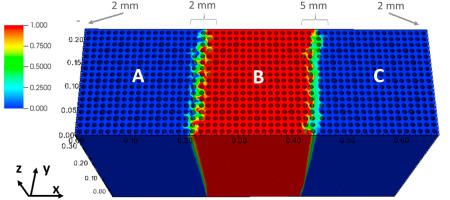当前位置:
X-MOL 学术
›
Prog. Nucl. Energy
›
论文详情
Our official English website, www.x-mol.net, welcomes your
feedback! (Note: you will need to create a separate account there.)
Hydraulic forces acting on full cross section fuel assemblies with 17×17 fuel rods
Progress in Nuclear Energy ( IF 3.3 ) Pub Date : 2020-12-01 , DOI: 10.1016/j.pnucene.2020.103515 Ulrich Bieder , Clarisse Genrault , Pierre Ledac
Progress in Nuclear Energy ( IF 3.3 ) Pub Date : 2020-12-01 , DOI: 10.1016/j.pnucene.2020.103515 Ulrich Bieder , Clarisse Genrault , Pierre Ledac

|
Abstract The pressure and velocity distribution within and between full cross-section fuel assemblies with generic but realistic mixing grids are analyzed by CFD using high performance computing (HPC). The reference fuel assembly consists of a bundle of 17 × 17 rods, including fuel rods, control rod guide tubes and a mixing grid with split type mixing vanes. The axial length of the analyzed domain spans approximately the interval between two successive mixing grids. Only hydraulic effects of the mixing grids on the behavior of the flow are analyzed, power input and heat transfer are not considered. The presented results are based on a well-validated calculation procedure. The intra-assembly exchanges and pressure fields were analyzed by modelling one single assembly, whereas the inter-assembly exchanges and pressure fields were analyzed by modelling a group of three horizontally aligned fuel assemblies, each build of 17 × 17 rods and a mixing grid. In the multi-assembly test cases, the water gaps that separate the central assembly from the neighboring fuel assembles vary between 2 mm and 10 mmm. In one additional test case, the rods of the central fuel assembly were slightly inclined in order to treat deformed assemblies. For a fuel assembly that is surrounded by water gaps of 2 mm, the total force (pressure and shear force) acting in flow direction upon one mixing grid is about 230 N. The total force working on the grid in cross flow direction is small. The prediction of this horizontal force can be falsified by inappropriate boundary conditions as symmetry. The total force acting upon the rods is about 160 N in flow direction and small in crossflow direction. Variations in the width of two oppositely located water gaps significantly influence the pressure force that is acting on the mixing grid in horizontal direction. Depending on the difference in the width of the water gaps, pressure forces of 39 N and 24 N were calculated for gap couples of 2 mm and 5 mm, and of 3 mm and 7 mm, respectively. This horizontally acting pressure force (Venturi force) tries to push the assembly in the direction to homogenize the water gap widths (self-stabilizing effect). The inclination of the rods of the central assembly does not lead to significant forces in cross flow direction. In order to assure this result, a calculation with very fine meshing (1000 million tetrahedrons) was performed.
中文翻译:

作用在具有 17×17 燃料棒的全截面燃料组件上的液压力
摘要 使用高性能计算 (HPC) 通过 CFD 分析具有通用但真实混合网格的全截面燃料组件内部和之间的压力和速度分布。参考燃料组件由一束 17 × 17 棒组成,包括燃料棒、控制棒导管和带有分体式混合叶片的混合格栅。分析域的轴向长度大约跨越两个连续混合网格之间的间隔。只分析了混合网格对流动行为的水力影响,不考虑功率输入和传热。所呈现的结果基于经过充分验证的计算程序。通过对单个组件建模,分析组件内交换和压力场,而组件间交换和压力场是通过模拟一组三个水平排列的燃料组件来分析的,每个组件由 17 × 17 棒和一个混合网格构成。在多组件测试案例中,将中央组件与相邻燃料组件隔开的水隙在 2 毫米到 10 毫米之间变化。在另一个测试案例中,中央燃料组件的杆略微倾斜,以处理变形的组件。对于一个被2mm水隙包围的燃料组件,作用在一个混合格栅上的沿流动方向的总力(压力和剪切力)约为230N。在横向流动方向作用在格栅上的总力很小。这种水平力的预测可能会被不适当的边界条件错误地作为对称性。作用在杆上的总力在流动方向上约为 160 N,在横流方向上很小。两个相对位置的水隙宽度的变化会显着影响水平方向作用在混合网格上的压力。根据水隙宽度的差异,分别为 2 毫米和 5 毫米以及 3 毫米和 7 毫米的间隙对计算出 39 N 和 24 N 的压力。这种水平作用的压力(文丘里力)试图将组件推向均匀水隙宽度的方向(自稳定效应)。中心组件杆的倾斜不会导致横向流动方向上的显着力。为了确保这一结果,我们进行了非常精细的网格划分(10 亿个四面体)计算。
更新日期:2020-12-01
中文翻译:

作用在具有 17×17 燃料棒的全截面燃料组件上的液压力
摘要 使用高性能计算 (HPC) 通过 CFD 分析具有通用但真实混合网格的全截面燃料组件内部和之间的压力和速度分布。参考燃料组件由一束 17 × 17 棒组成,包括燃料棒、控制棒导管和带有分体式混合叶片的混合格栅。分析域的轴向长度大约跨越两个连续混合网格之间的间隔。只分析了混合网格对流动行为的水力影响,不考虑功率输入和传热。所呈现的结果基于经过充分验证的计算程序。通过对单个组件建模,分析组件内交换和压力场,而组件间交换和压力场是通过模拟一组三个水平排列的燃料组件来分析的,每个组件由 17 × 17 棒和一个混合网格构成。在多组件测试案例中,将中央组件与相邻燃料组件隔开的水隙在 2 毫米到 10 毫米之间变化。在另一个测试案例中,中央燃料组件的杆略微倾斜,以处理变形的组件。对于一个被2mm水隙包围的燃料组件,作用在一个混合格栅上的沿流动方向的总力(压力和剪切力)约为230N。在横向流动方向作用在格栅上的总力很小。这种水平力的预测可能会被不适当的边界条件错误地作为对称性。作用在杆上的总力在流动方向上约为 160 N,在横流方向上很小。两个相对位置的水隙宽度的变化会显着影响水平方向作用在混合网格上的压力。根据水隙宽度的差异,分别为 2 毫米和 5 毫米以及 3 毫米和 7 毫米的间隙对计算出 39 N 和 24 N 的压力。这种水平作用的压力(文丘里力)试图将组件推向均匀水隙宽度的方向(自稳定效应)。中心组件杆的倾斜不会导致横向流动方向上的显着力。为了确保这一结果,我们进行了非常精细的网格划分(10 亿个四面体)计算。











































 京公网安备 11010802027423号
京公网安备 11010802027423号